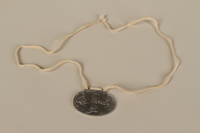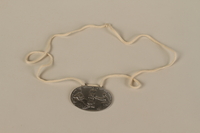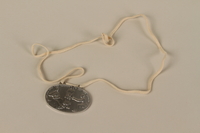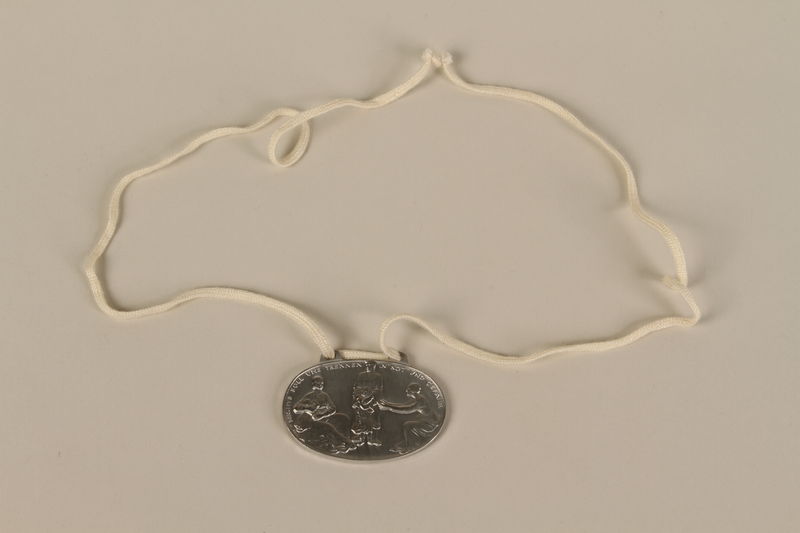Overview
- Brief Narrative
- Identification tag issued to six-year-old Vera Lechtman in 1944 while in the care of a children’s home in Switzerland run by Margaret Locher, after escaping France with her mother, Tonia, and brother, Marcel. The tag is engraved with her name and birthdate, the name of her foster parent, and the address of the home. Vera was born in Paris, France, to Russian and Polish parents, who had immigrated to France from Palestine as a result of being forced out for their communist activities. Her father, Sioma, fought for the Communist International Brigade in the Spanish Civil War, and was subsequently interned in several camps in France before being deported to Auschwitz. In 1940, Tonia sent Vera and Marcel to a children’s home in Limoges. While there, Tonia met a Swiss woman named Margaret Locher, who visited the home for several weeks. In 1942, Tonia, Vera, and Marcel were arrested and sent to the Nexon internment camp, from where they were supposed to be deported. A local officer arranged their release, and they returned to Limoges to hide before escaping to Switzerland. They stayed in refugee camps until April 1943, when Vera and Marcel were placed in the care of their mother’s friend, Margaret Locher, who opened a home near Zurich named “Rebhaus,” for Jewish children whose parents were in internment or refugee camps. After the war's end in 1945, Tonia began doing relief work with the Unitarian Universalist Service Committee in France, Germany, and Poland. Vera and Marcel remained with Margaret until late 1947, when they were able to join Tonia in her native country of Poland.
- Date
-
manufacture:
1944
use: 1944-before 1947 December
- Geography
-
issue:
Küsnacht (Switzerland)
- Credit Line
- United States Holocaust Memorial Museum Collection, Gift of Vera Lechtman
- Contributor
-
Subject:
Vera Lechtman
Issuer: Margaret Locher
- Biography
-
Vera Lechtman (b. 1938) was born to Sioma (1916-1945?) and Tonia (nee Bialer,1918-1996) Lechtmann in Paris, France. Born in Dunajewce, Russia (now Dunaivtsi, Ukraine), Sioma soon moved with his parents Israel and Feiga (nee Blatt) Lechtmann to Vienna, Austria. He had three sisters: Hava and twins, Luba and Buza. Following a period of increasing violence and the outbreak an Austrian civil war in 1934, the family immigrated again to British-controlled Palestine, where he began working in construction, met, and married Tonia Bialer (1918-1998). Tonia’s family—parents Aharon (1890-1961) and Rachel (nee Wojdyslauza [Wermeister?], 1892-1967) Bialer, and siblings Avraham (Romek, 1912-1945), Joel (Julek, 1919-1999), and Noemi (Ema)—had emigrated from Łódź, Poland, that same year, following Tonia’s brief imprisonment for communist activities.
Both Sioma and Tonia joined the M.K.P. (Palestinian Communist Party). In 1936, after their marriage, both were arrested by the British authorities for their communist political activity, and later forced to leave Palestine. Considered stateless, they could not be deported to a specific country and were free to go where they wanted. They left in 1937 to join the fight against fascism in the Spanish Civil War. They traveled first to Paris, France, where Tonia realized she was pregnant. After completing training in France, Sioma continued to Spain and joined the Austrian division of the Communist International Brigade. Tonia remained in Paris, where she gave birth to her first child, Vera, on June 26, 1938.
Near the end of the war, Sioma’s brigade and the defeated Republican fighters they supported fled from Spain to France, a country that agreed to take the fighters. On February 8, 1939, Sioma was sent to Saint-Cyprien, a reception center for Spanish refugees, and later, an internment camp for foreigners. Tonia and Vera moved to Oloron St. Marie to be closer to Sioma. Later that spring, he was among almost 19,000 refugees transferred to a new camp at Gurs in southwestern France. Tonia was able to visit him in June 1939, and introduced him to Vera. Although Tonia never saw Sioma again, she gave birth to Vera’s brother, Marcel, nine months later, on March 31, 1940.
In September 1939, in accordance with the Molotov Ribbentrop Pact, Germany and Russia invaded Poland. In response, Britain and France declared war on Germany. Subsequently, Gurs was transformed from a refugee camp to an internment camp for “enemy aliens.” German forces invaded France on May 10, 1940, and on June 5, Sioma was sent from Gurs to Le Vernet D’Ariege, which was turned into a penal camp by the Vichy government. Tonia managed to get visas for the family to immigrate to Mexico, but Sioma declined, believing he would be needed to fight in the French Resistance. Tonia refused to leave without Sioma, and in 1940, she sent the children to the Pouponniere children's home in Limoges, run by Hanna Gruenwald, a Jewish German psychologist from Paris. The home was established by the Organisation de secours aux enfants (OSE, Children’s Aid Society), who cared for refugee children and Jewish children whose families were at risk for deportation. Tonia was eventually hired there, and met Margaret Locher, who visited the home for several weeks.
Sioma was held in Vernet until August 8, 1942, when he was part of the convoys transported to Drancy, a transit camp to the east. Four days later, Sioma was deported on convoy 18 to Auschwitz killing center in German-occupied Poland, where he was given prisoner number 58935. His initial work assignment digging coal caused him to get sick, and he was placed on a list for the gas chamber. Hermann Langbein, a prisoner working in the hospital, convinced the S.S. doctor to transfer him to the treatment ward instead. Sioma had multiple hospital stays, x-rays, and a surgery. Despite his illnesses, he was also employed while in the camp. Sioma likely perished during a death march in 1945.
In 1942, the Vichy government forced all Jews to relocate, and Tonia moved the family to St. Leonard de Mari. In September, a French police officer forcibly relocated them to the Nexon internment camp, from which they were to be deported to Poland. Tonia, Vera, and Marcel were already loaded in the cattle truck when the camp commander felt pity for her two small children and let them get off the truck. They returned to Limoges to hide in the children’s home. With the help of a priest, they eventually made their way to the Swiss border, and crossed near Geneva on October 11, 1942. Although Switzerland had a tradition of wartime neutrality and helping refugees, the threat of a German invasion led them to limit the number of foreigners it allowed into the country, put refugees in camps, and prohibited those coming from France.
At first, Tonia and the children lived at a refugee camp named “Les Hirondelles” near Geneva, Switzerland. On November 20, Vera and Marcel were taken to the Ascona children’s camp, and Tonia was transferred to the Les Avants camp. On April 20, 1943, Vera and Marcel were placed in the care of Margaret Locher, who ran a home near Zurich named “Rebhaus” for Jewish children whose parents were in internment or refugee camps. While in Zurich, Tonia took a course in social work under the direction of Noel Field, an American working for the Unitarian Universalist Service Committee (UUSC). After the war ended in 1945, she led a UUSC team of Polish doctors to displaced persons (DP) and refugee camps in France and Germany. Vera and Marcel remained in the children’s home in Zurich. In 1946, she began working on a UUSC hospital project in Poland; Vera and Marcel joined her there in late 1947. Due to her connection with Noel Field (a former Soviet spy) in July 1949, Tonia was accused by her neighbors of being a spy and imprisoned by Polish authorities. As a result, Marcel and Vera were placed in a state-run orphanage. After five years, Tonia was released. Vera attended Warsaw Polytechnic University, after completing high school. She became a pediatrician, married a Christian Pole, and had two children. The family remained in Poland until 1968, when antisemitic violence led Marcel to leave the country for Sweden. Although Vera’s husband was forced to remain in Poland, Tonia, Vera, and her two children immigrated to Israel in 1971, where they still had family.
Margaret Locher lived in Zurich, Switzerland. In March 1943, she left her home in Zurich and moved temporarily to the city of Lugano, near the Italian border. On April 20, she began fostering the children of Tonia Lechtmann, a friend she had met while visiting a children’s home in Limoges, France. In June, Margaret was able to secure Tonia’s release from Les Avants camp to join the children. On July 1, she opened a home named “Rebhaus” in Küsnacht, near Zurich, for Jewish children whose parents were in internment or refugee camps. After a couple of weeks, Tonia and her children joined her at the Rebhaus. In addition to the Lechtmann children, Margaret adopted an orphan from France, and fostered three other children.
In April 1944, Margaret and Tonia were caring for seven children. Tonia left to take a course in Zurich, and in June, Margaret was able to hire Irene Maringer, the mother of another of her charges. Irene worked for Margaret for two months, and her son, Georges, stayed in the home until November 1945. Following the end of the war, the remaining children returned to the parents after they had reestablished themselves. Tonia’s children stayed with Margaret until the winter of 1947.
Physical Details
- Language
- German
- Classification
-
Identifying Artifacts
- Category
-
Labels
- Object Type
-
Name tags (lcsh)
- Genre/Form
- Tags.
- Physical Description
- Oval, metal tag with 2 attached rings on top, connected by a string formed into a loop, and made to wear around the neck. The front has an embossed image of a seated woman with a baby, a standing man with a child, and a second seated woman reaching towards the other woman with an engraved inscription around the top edge. The back is engraved and etched with identifying text.
- Dimensions
- overall: Height: 1.375 inches (3.493 cm) | Width: 1.875 inches (4.763 cm)
- Materials
- overall : metal, string
- Inscription
- front, stamped on top edge : NICHTS SOLL UNS TRENNEN IN NOT UND GEFAHR [Nothing will divide us in trouble and danger]
back, top stamped : KANTON ZÜRICH 1944
back, etched hand etched in center : 26.6.38. / Lechtmann, Vera / Zumikerstrasse / b / locher / Küsnacht / zch.
back, bottom, center, stamped : MuGuEnin
Rights & Restrictions
- Conditions on Access
- No restrictions on access
- Conditions on Use
- No restrictions on use
Keywords & Subjects
Administrative Notes
- Legal Status
- Permanent Collection
- Provenance
- The name tag was donated to the United States Holocaust Memorial Museum in 2008 by Vera Lechtman.
- Record last modified:
- 2023-10-24 10:55:36
- This page:
- https://collections.ushmm.org/search/catalog/irn37081
Also in Vera Lechtman collection
The collection consists of artifacts relating to the experiences of Vera and Marcel Lechtman, Georges Maringer, and Marc Hoffman as rescued children in Switzerland during the Holocaust.
Date: 1944

Identification tag with name and birthdate issued to a Jewish refugee child
Object
Identification tag issued to four-year-old Marcel Lechtman in 1944 while in the care of a children’s home in Switzerland run by Margaret Locher, after escaping France with his mother, Tonia, and sister, Vera. The tag is engraved with his name and birthdate, the name of his foster parent, and the address of the home. Marcel was born in Oloron-Sainte-Marie, France, to Russian and Polish parents, who had immigrated to France from Palestine as a result of being forced out for their communist activities. His father, Sioma, fought for the Communist International Brigade in the Spanish Civil War, and was subsequently interned in several camps, including Saint-Cyprien, before being deported to Auschwitz. In 1940, Tonia sent Marcel and Vera to a children’s home in Limoges. While there, Tonia met a Swiss woman named Margaret Locher, who visited the home for several weeks. In 1942, Tonia, Vera, and Marcel were arrested and sent to the Nexon internment camp, from where they were supposed to be deported. A local officer arranged their release, and they returned to Limoges to hide before escaping to Switzerland. They stayed in refugee camps until April 1943, when Marcel and Vera were placed in the care of their mother’s friend, Margaret Locher, who opened a home near Zurich named “Rebhaus,” for Jewish children whose parents were in internment or refugee camps. After the war's end in 1945, Tonia began doing relief work with the Unitarian Universalist Service Committee in France, Germany, and Poland. Marcel and Vera remained with Margaret until late 1947, when they were able to join Tonia in her native country of Poland.

Identification tag with name and birthdate issued to a Jewish refugee child
Object
Identification tag issued to three-year-old Georges Maringer in 1944 while in the care of a children’s home in Switzerland run by Margaret Locher, after escaping France with his mother, Irene, and father, Simon. The tag is engraved with his name and birthdate, the name of his foster parent, and the address of the home. Georges was born in France, to Jewish parents, Simon and Irene Maringer. Simon completed a Ph.D. in Psychology at the University of Zurich in 1936, and began attending medical courses in Brussels. Simon and Irene were forced to flee Belgium in 1940, after the German invasion. On December 1, 1941, Irene gave birth to their son, Georges, in L'Isle Jourdain, just outside of Toulouse. Fearing arrest and deportation, they moved around until September 1942, when they crossed the border into Switzerland. The family stayed together at Les Avants refugee camp, where they became acquainted with Tonia Lechtmann. In August 1943, Georges was placed the care of Margaret Locher, who ran a home near Zurich named “Rebhaus” for Jewish children whose parents were in internment or refugee camps. Among Georges’ foster siblings were Vera and Marcel Lechtman, the children of Tonia, and Marc Hoffmann. Simon worked in a series of camps as a doctor, and in May 1944 moved to Basel to complete his medical education. Irene was sent to women’s camps until June 1944, when she spent two months working for Margaret at the children’s home. Irene followed Simon to Basel in September 1945, and Georges joined them that same year in November. The family lived in Basel until 1948, when they immigrated to the United States.

Identification tag with name and birthdate issued to a Jewish refugee child
Object
Identification tag issued to five-year-old Marc Hoffmann in 1944 while in the care of a children’s home in Switzerland run by Margaret Locher, after escaping France with his mother, Helene, and father, Charles. The tag is engraved with his name and birthdate, the name of his foster parent, and the address of the home. Marc was born in Paris, France, to Polish parents. In the summer of 1942, fearing arrest and deportation, the family submitted a declaration for admission to Switzerland. They did not receive approval, and illegally crossed the border in October. They were placed together in Camp Les Charmilles in Geneva until November 11, when Marc was placed at the Wartheim children’s home. He stayed there until July 19, 1943, when he was placed in the care of Margaret Locher, who ran a home near Zurich named “Rebhaus” for Jewish children whose parents were in internment or refugee camps. Among Marc’s foster siblings were Vera and Marcel Lechtman, and Georges Maringer. Charles was moved around to multiple camps within Switzerland until May 1945, when he escaped and illegally crossed the border back into France. Helene was also transferred among multiple camps, and while being held completed a course and internship as a seamstress. Helene returned to France in March 1946, but Marc had to stay behind for health reasons. He was permitted to return to France that September.





